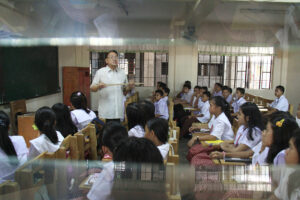Ramp up education spending next year, Congress told
PHILIPPINE lawmakers should boost next year’s funding for programs geared toward improving early mathematics, literacy, and modern training courses for teachers to address the poor performance of Filipino students in these subjects compared to their global counterparts, analysts said at the weekend.

By John Victor D. Ordoñez, Reporter
PHILIPPINE lawmakers should boost next year’s funding for programs geared toward improving early mathematics, literacy, and modern training courses for teachers to address the poor performance of Filipino students in these subjects compared to their global counterparts, analysts said at the weekend.
“Incentives can also be provided for teachers to specialize in science technology, engineering, mathematics which are critical to reducing math anxiety and improving teaching pedagogies,” John Paolo R. Rivera, a senior research fellow at the Philippine Institute for Development Studies (PIDS), said in a Viber message.
“Government may allocate funding for early childhood education programs that introduce foundational math concepts in an engaging and stress-free environment.”
In the Organization for Economic Cooperation and Development’s (OECD) 2022 Programme for International Student Assessment (PISA) published on Nov. 14, Filipino students showed among the highest levels of mathematics anxiety among 15-year-old students globally.
Previously, 16% of Filipino students attained at least Level 2 proficiency in mathematics, significantly lower than the 69% average across OECD countries.
“The government should allocate funds to build more additional school buildings because having more than 30 students affect the quality of learning, teachers training, hire additional admin staff to lighten the load of teachers from too many administrative tasks,” Maria Ella Calaor-Oplas, an economics professor who specializes in human capital development research at De La Salle University, said in a Facebook Messenger chat.
The Department of Education has been allocated some P751.68 billion next year, while state colleges and universities will be given a budget of P117.97 billion, based on the Senate’s Finance committee report of the 2025 national budget bill.
Senators are set to start proposing amendments to the proposed 2025 P6.352-trillion budget this week.
Last year, the Education department failed to meet its target of building 6,379 classrooms, having only built 3,600.
Senator Sherwin T. Gatchalian earlier said the country lacks about 165,443 classrooms around the country.
Senator and Finance Committee chairperson Mary Grace Natividad S. Poe-Llamanzares earlier said the budget bill would include an additional P9.9 billion for teaching materials next year.
“More support must be given to local education boards to help them perform their mandates,” Michael Henry Ll. Yusingco, a fellow at the Ateneo de Manila University Policy Center, said in a Facebook Messenger chat. “Their autonomy must be zealously protected. And the community itself must do their part here.”
In an earlier assessment by the OECD, the Philippines ranked 63rd out of 64 countries in a 2022 global assessment that ranked 15-year-old students worldwide in producing and evaluating original ideas that would translate into effective solutions.
Filipino students were also among the world’s weakest in mathematics, reading and science as the Philippines ranked 77th out of 81 countries in all categories, performing worse than the global average in another PISA 2022 assessment.
On the other hand, the Philippines placed 22nd out of 111 countries in the 2022 English Proficiency Index by Education First.
“The investment is simple: restore the education in mother tongue policies then invest in training faculty and upgrade the basic facilities of basic education institutions,” Hansley A. Juliano, who teaches political science at the Ateneo de Manila University, said in a Facebook Messenger chat.
“You cannot teach in a place with subpar facilities and places you cannot conduct classes when the heat rises or when it rains.”
The Second Congressional Commission on Education (EDCOM II) and the PIDS said in a report in May that there is a “severe underinvestment” in the welfare of very young children in the Philippines, causing their early education to suffer.
The government only spends about P3,870 per child for health, compared with the $150 (P8,809.95) that other lower and middle-income countries spend on children’s health, the report showed.
Meanwhile, a recent survey found 31% and 30% of Gen Z and Millennial Filipinos, respectively cited the quality of education as the top challenge faced by the country.
Filipinos also emerged as the least satisfied with the cost of education in Southeast Asia with a satisfaction rate of 43% and 38% for Gen Zs and millennials, respectively.
This is based on a survey, conducted by Vero Advocacy and Kadence International, which polled over 2,700 Millennials and Gen Z respondents from six Southeast Asian nations, including 453 Filipinos.
Despite being among Southeast Asia’s least satisfied with employment opportunities, education quality, and healthcare access, Filipino youth remain hopeful about their future, it also found.
It found that more than 42% of young Filipinos expect their lives to improve in the next five years, signaling strong resilience even as they face critical issues in their daily lives.
The survey showed that 43% of Gen Z Filipinos anticipate a “much better” future, with another 42% expecting it to be “better.”
Millennials share similar levels of optimism at 84%, placing young Filipinos among the region’s most hopeful.
They were more optimistic than their peers in Singapore (69%) and Malaysia (77%), and nearly on par with youth in Indonesia, Vietnam, and Thailand, where optimism rates hover around 89%. — with Chloe Mari A. Hufana
















